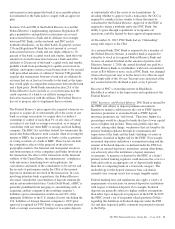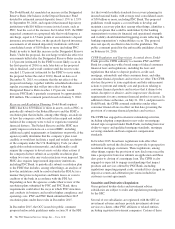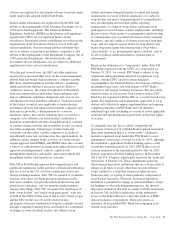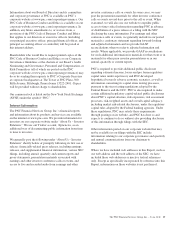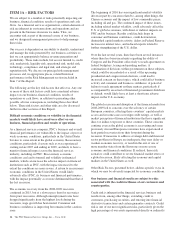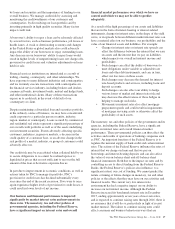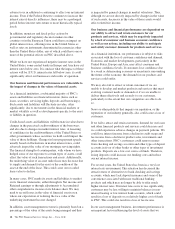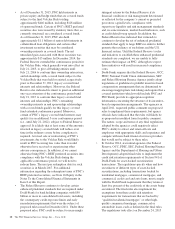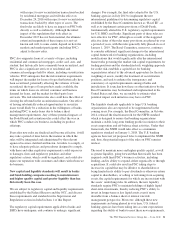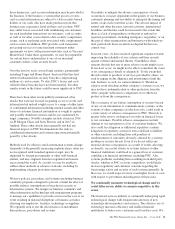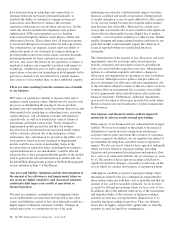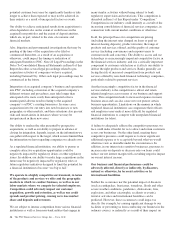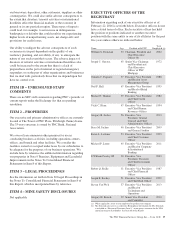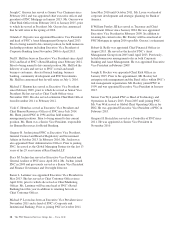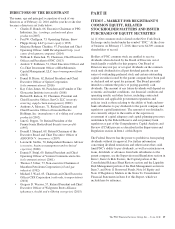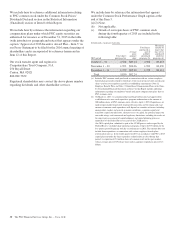PNC Bank 2015 Annual Report Download - page 39
Download and view the complete annual report
Please find page 39 of the 2015 PNC Bank annual report below. You can navigate through the pages in the report by either clicking on the pages listed below, or by using the keyword search tool below to find specific information within the annual report.with respect to new securitization transactions backed
by residential mortgages and will take effect on
December 24, 2016 with respect to new securitization
transactions backed by other types of assets. The
final rules are likely to have an impact on PNC both
directly as well as indirectly. Although the initial
impact of the regulations that took effect in
December 2015 has not been material, the ultimate
extent and magnitude of these impacts is not yet
known and will, to some extent, depend on how the
markets and market participants (including PNC)
adjust to the new rules.
PNC also originates loans of a variety of types, including
residential and commercial mortgages, credit card, auto, and
student, that historically have commonly been securitized, and
PNC is also a significant servicer of residential and
commercial mortgages held by others, including securitization
vehicles. PNC anticipates that the risk retention requirements
will impact the market for loans of types that historically have
been securitized, potentially affecting the volumes of loans
securitized, the types of loan products made available, the
terms on which loans are offered, consumer and business
demand for loans, and the market for third-party loan
servicers. The risk retention rules also could have the effect of
slowing the rebound in the securitization markets. One effect
of having substantially reduced opportunities to securitize
loans would likely be a reduction in the willingness of banks,
including PNC, to make loans due to balance sheet
management requirements. Any of these potential impacts of
the Dodd-Frank risk retention rules could affect the way in
which PNC conducts its business, including its product
offerings.
Even after new rules are finalized and become effective, it still
may take a period of time before the manner in which the
rules will be interpreted and administered by the relevant
agencies becomes clarified and known. A failure to comply, or
to have adequate policies and procedures designed to comply,
with these and other regulatory requirements could expose us
to damages, fines and regulatory penalties and other
regulatory actions, which could be significant, and could also
injure our reputation with customers and others with whom we
do business.
New capital and liquidity standards will result in banks
and bank holding companies needing to maintain more
and higher quality capital and greater liquidity than has
historically been the case.
We are subject to regulatory capital and liquidity requirements
established by the Federal Reserve and the OCC, and discuss
these requirements and standards in the Supervision and
Regulation section included in Item 1 of this Report.
The regulatory capital requirements applicable to banks and
BHCs have undergone, and continue to undergo, significant
changes. For example, the final rules adopted by the U.S.
banking agencies in July 2013 to implement the new
international guidelines for determining regulatory capital
established by the Basel Committee known as “Basel III”, as
well as to implement certain provisions of Dodd-Frank,
fundamentally altered the U.S. regulatory capital requirements
for U.S. BHCs and banks. Significant parts of these rules are
now effective for PNC, although as a result of the staggered
effective dates of the rules many provisions are phased-in over
a period of years, with the rules generally fully phased-in as of
January 1, 2019. The Basel Committee, moreover, continues
to consider additional, significant changes to the international
capital framework for banking organizations, including
modifications that would significantly alter the international
frameworks governing the market risk capital requirements for
trading positions and the standardized risk weighting approach
for credit risk, establish a capital floor for banking
organizations subject to the advanced approaches for the risk
weighting of assets, modify the treatment of securitization
positions, and seek to enhance the transparency and
consistency of capital requirements amongst banks and
jurisdictions. It is unclear how these or other initiatives by the
Basel Committee may be finalized and implemented in the
United States and, thus, we are unable to estimate what
potential impact such initiatives may have on PNC.
The liquidity standards applicable to large U.S. banking
organizations also are expected to be supplemented in the
coming years. For example, the Basel Committee, in October
2014, released the final framework for the NSFR standard,
which is designed to ensure that banking organizations
maintain a stable, long-term funding profile in relation to their
asset composition and off-balance sheet activities. Under that
framework, the NSFR would take effect as a minimum
regulatory standard on January 1, 2018. The U.S. banking
agencies have not yet proposed rules to implement the NSFR
and, thus, the potential impact of the rules on PNC remains
unclear.
The need to maintain more and higher quality capital, as well
as greater liquidity, going forward than historically has been
required could limit PNC’s business activities, including
lending, and its ability to expand, either organically or through
acquisitions. It could also result in PNC taking steps to
increase its capital that may be dilutive to shareholders or
being limited in its ability to pay dividends or otherwise return
capital to shareholders, or selling or refraining from acquiring
assets, the capital requirements for which are inconsistent with
the assets’ underlying risks. In addition, the new liquidity
standards require PNC to maintain holdings of highly liquid
short-term investments, thereby reducing PNC’s ability to
invest in longer-term or less liquid assets even if more
desirable from a balance sheet or interest rate risk
management perspective. Moreover, although these new
requirements are being phased in over time, U.S. federal
banking agencies have been taking into account expectations
regarding the ability of banks to meet these new requirements,
The PNC Financial Services Group, Inc. – Form 10-K 21


